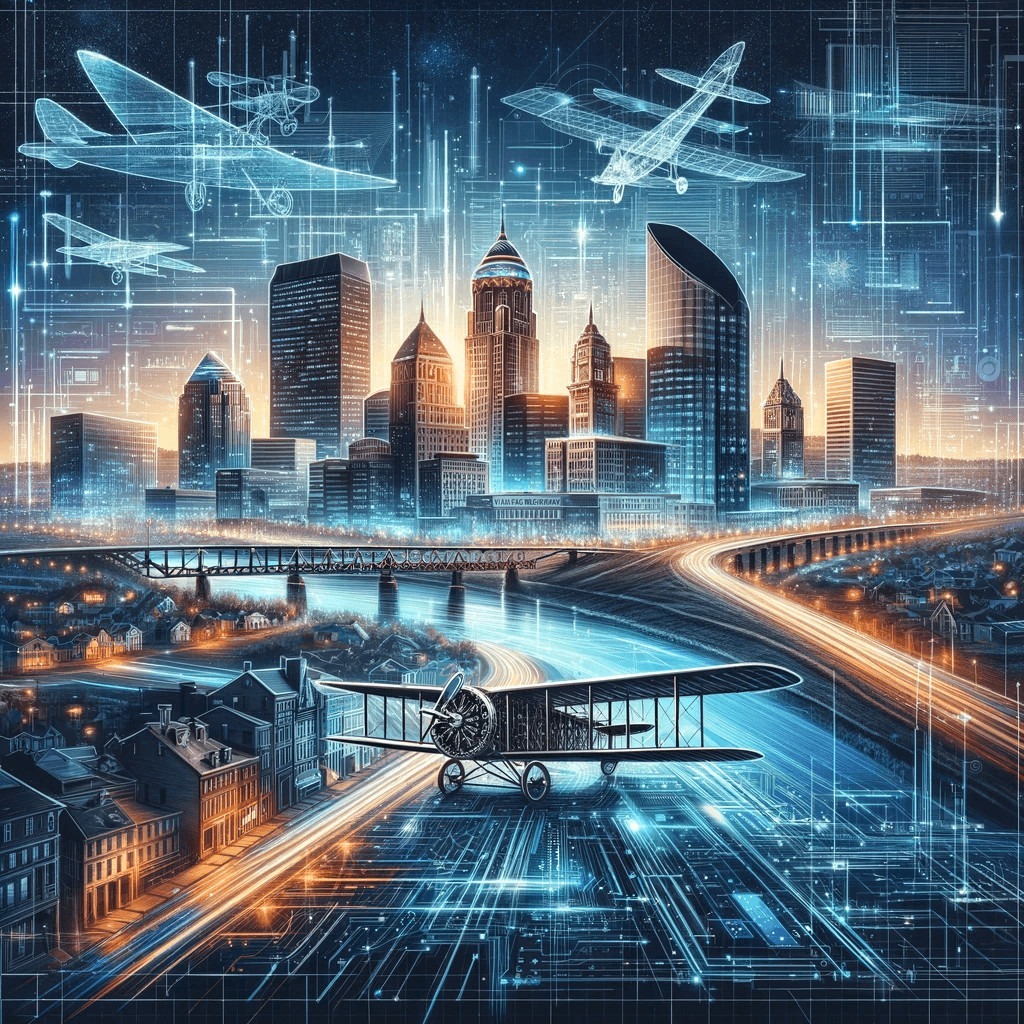Gem City 3D
Nestled in southwest Ohio’s Miami Valley, Dayton is a mid-sized industrial city with a remarkable history of innovation. Nicknamed the “Gem City”, Dayton was a hub of technology and invention in the late 19th and early 20th century that helped shape modern America.
This article will chronicle Dayton’s fascinating journey from its early beginnings to its rise as a global innovation leader. We’ll learn how Dayton earned its “Gem City” nickname and fueled advancements in aviation, computing, automotive and manufacturing. Understanding Dayton’s storied past provides inspiration for the city’s next chapter.

Dayton’s origins trace back to the late 1700s when Revolutionary War veteran Jonathan Dayton bought land in southwest Ohio near the confluence of the Great Miami, Stillwater and Mad Rivers. Drawn by the area’s natural resources and location, settlers established the town of Dayton in 1796.
Dayton grew steadily as a commercial and manufacturing hub, strategic for river transport and its proximity to rail lines. By 1850, Dayton was connecting Ohio to the national railroad system as a junction for major east-west and north-south routes. Access to transportation fueled industry growth.
Some key events in Dayton’s early development:
Dayton’s most famous inventors undoubtedly are Wilbur and Orville Wright who revolutionized human transportation with the first powered airplane flights.
Drawn to Dayton for its skilled manufacturing capabilities, the Wright brothers operated a successful bicycle shop while pursuing their dream of flight. They assembled a talented team to help iteratively design and build pioneering airplanes.
Groundbreaking innovations by the Wright brothers in Dayton:
After hundreds of concept iterations, the Wright brothers successfully flew the first powered airplane on December 17, 1903 near Kitty Hawk, NC. Their perseverance and creativity made manned flight possible, launching the aerial age.
In 1884, mechanical engineer John Patterson founded the National Cash Register Company (NCR) in Dayton to manufacture cash registers. Under Patterson’s shrewd management, NCR became a phenomenally successful early tech company.
Patterson recruited talented engineers like Charles Kettering, instituted employee profit sharing, and ran innovative marketing campaigns. By 1922 NCR was a multi-million dollar firm dominating the cash register market.
Notable NCR milestones:
NCR’s technology focus and talented workforce established Dayton as a global tech leader early on. The NCR legacy continues to spur innovation in the city.
Alongside NCR’s rise, Dayton also became a hotbed of automotive invention in the early 1900s led by engineer Charles Kettering and his legendary Dayton Engineering Laboratories Company (Delco).
Founded in 1909, Delco was instrumental in automotive advances under the ownership of General Motors:
This profusion of auto innovation earned Dayton the moniker “Little Detroit.” Automotive breakthroughs drove prosperity in Dayton for decades.
With aerospace pioneers like the Wright brothers, Dayton was destined to become a hub for aviation. Early successes include:
Their efforts paid off in July 1921 when the Army named Dayton to host a major aircraft repair, supply and distribution center. This depot formed the foundation for the Dayton Aeronautical Systems Center and Wright-Patterson Air Force Base.
Other Dayton aviation firsts:
Dayton has been advancing aviation technology for over 100 years and continues its aerospace leadership.
In March 1913, the Great Flood devastated Dayton as the Miami River breached its banks after days of heavy rain. By March 26, water reached 10 to 20 feet downtown. Nearly 100,000 people were displaced as 365 city blocks were submerged.
Yet Dayton citizens remarkably rallied. John Patterson of NCR took charge of relief efforts, organizing evacuations, restoring utilities and raising funds to rebuild. Within 3 months, most houses and businesses were repaired.
The flood levied immense damage, but Dayton emerged more resilient. The city implemented measures to prevent future floods, including:
The community spirit and refusal to succumb to catastrophe reflected Dayton’s determined character.
Known as a “city of a thousand factories”, Dayton fostered an exceptional culture of innovation that enabled breakthroughs across diverse fields:
Manufacturing:
Materials science:
Consumer goods:
Dayton’s concentration of technical talent, hands-on workmanship and collaborative culture bred innovation.
Like many Midwest manufacturing cities, Dayton experienced economic declines and urban blight starting in the 1960s. But in the past decade, major revitalization efforts have sparked downtown development.
Recent initiatives:
Dayton is experiencing a 21st century renaissance by celebrating its past while creating an inviting future.
After its heyday as a manufacturing powerhouse, Dayton has evolved into a diversified city strategically rebuilding around aviation, aerospace, information technology and advanced manufacturing.
Education and research powerhouses like University of Dayton and Wright State University provide talent. Incubators assist entrepreneurs and startups. The region’s logistics access, affordable costs and livability attract businesses.
But Dayton also recognizes that diversity, inclusion and rising living standards for all citizens must accompany growth.
As Dayton writes its next chapter, its goal is to channel the innovative drive of its past to build an equitable and sustainable future. The Gem City’s spirit shines bright.
Dayton’s evolution from a frontier river town into the birthplace of flight and a technology leader reflects the persevering Midwestern grit of its people. Against challenges like economic swings and natural calamities, Daytonans retained their core identity as problem-solving builders and inventors.
The same spirit that animated Dayton’s engineers, entrepreneurs and workers to create cash registers, airplanes and automobiles perseveres today. Dayton’s foundations and resilience position it for a new wave of progress. By boldly reimagining its possibilities, the Gem City’s brightest days may still lie ahead.